Scuba Diving the Waterways of Central Texas
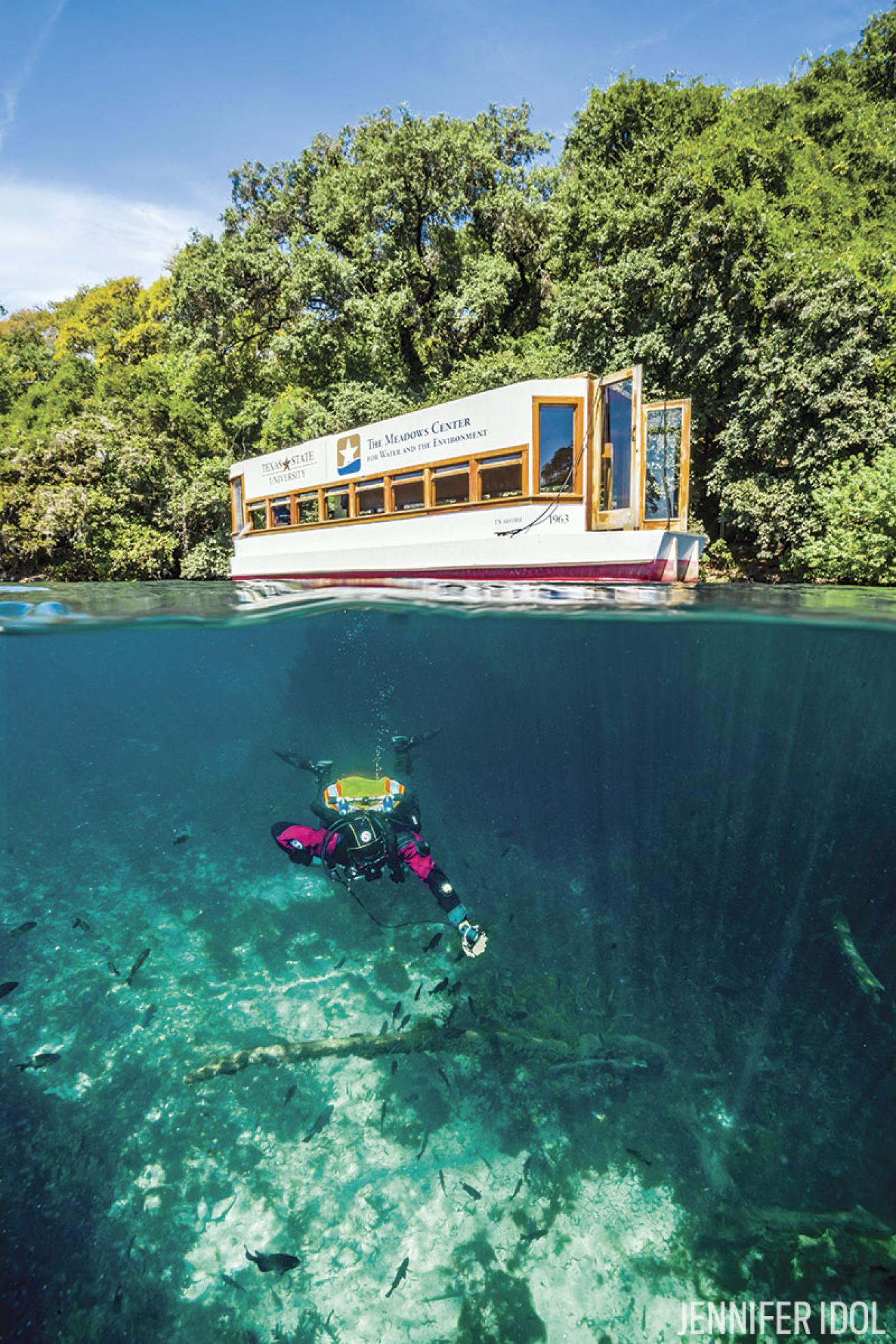
Jennifer IdolSometimes divers are the main show at Aquarena Springs.
My journey diving across all 50 states for my book An American Immersion took me to extraordinary dive sites — and away from my home in central Texas. Now I’m rediscovering my favorite destinations, filled with diverse life. I missed seeing the spotted gar in Spring Lake and finding big catfish in other lakes, as well as the divers I usually meet in this active diving community.
You’ll find cool, clear water at the Comal River, at the edge of Hinman Island Park in New Braunfels. Water flows briskly from its spring, supporting a diverse ecosystem that includes small fish and crawfish.
Once in the water, be prepared to be swept downstream and taken on a drift dive. If you kick, you will reach the exit in 15 minutes. Drifting without kicking will make the dive last 30 minutes. Depths reach 10 feet by the tube shoot but average 5 feet.
Most divers exit at the staircase before the tube shoot, but I have ventured with buddies down the river to see the entire length, extending the dive to an hourlong experience in shallow water. We ride the shoot with fully inflated BCs and kick out of the pool at the bottom to begin this part of the dive.
The San Marcos River features much of the same ecosystem found in Spring Lake. Enter in Sewell Park, drift to Rio Vista Park, and get out before the waterfall. If you’re lucky you might see the American eel, a remarkable fish that migrates to the ocean at maturity.
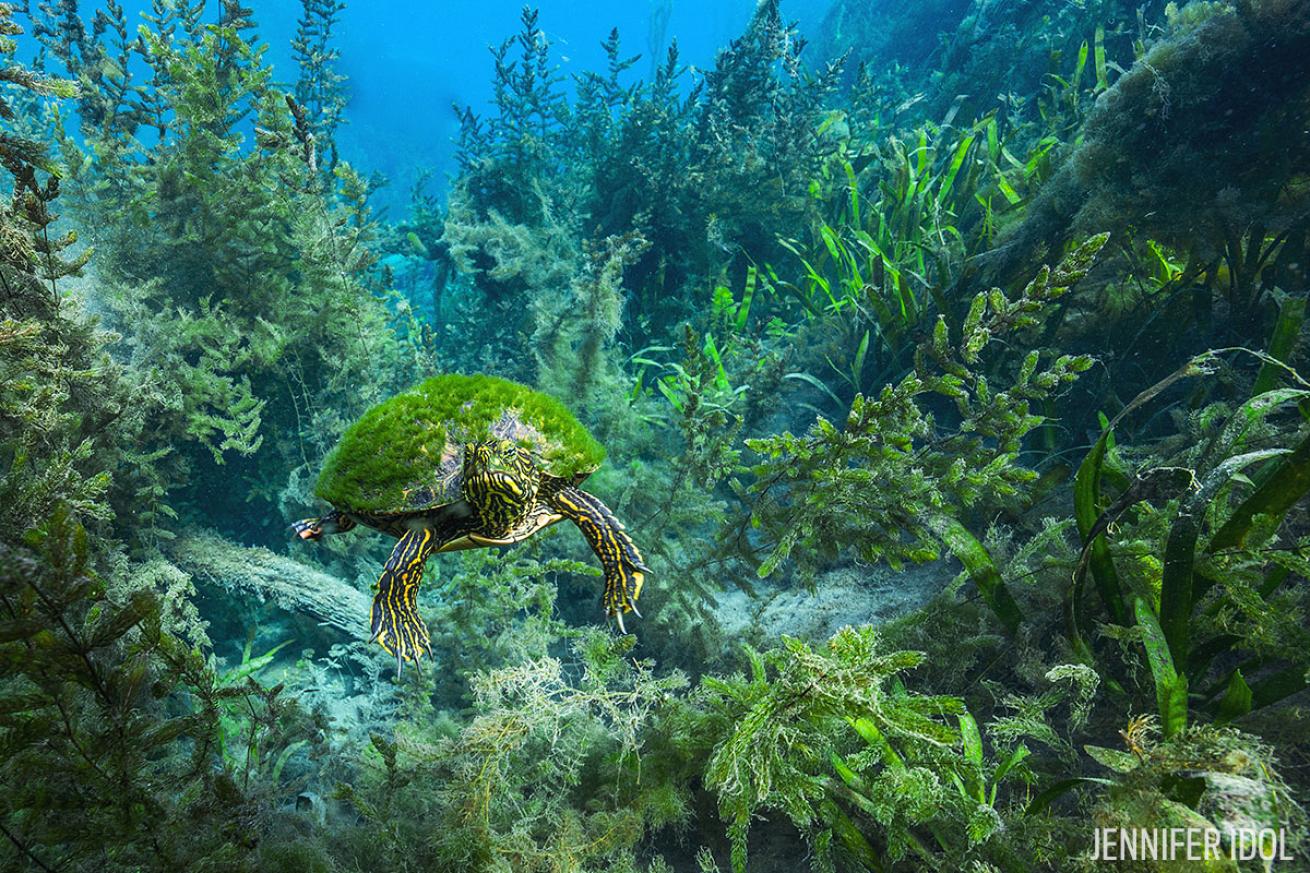
Jennifer IdolA yellow-bellied slider cruises through Spring Lake.
CENTRAL TEXAS GEM
Spring Lake glistens in the sun, attracting wildlife and other visitors since the Ice Age. Clovis Indians inhabited the area, replaced later by
Spaniards, and eventually by us. The spring was known as Aquarena Springs when it operated as a theme park with mermaids and Ralph the diving pig in the 1960s through the 1980s.
Now part of Texas State University, the Meadows Center for Water and the Environment manages this aquifer-fed spring.
San Marcos Springs and Spring Lake were designated a critical habitat by the U.S. Fish and Wildlife Department and Texas Parks and Wildlife because the area is home to eight known species listed as endangered or threatened, including the fountain darter, San Marcos salamander, San Marcos gambusia, Texas blind salamander and Texas wild rice. Spotted gar, yellowbellied sliders, alligator turtles, sunfish and cabomba vegetation are also prolific in this unique ecosystem.
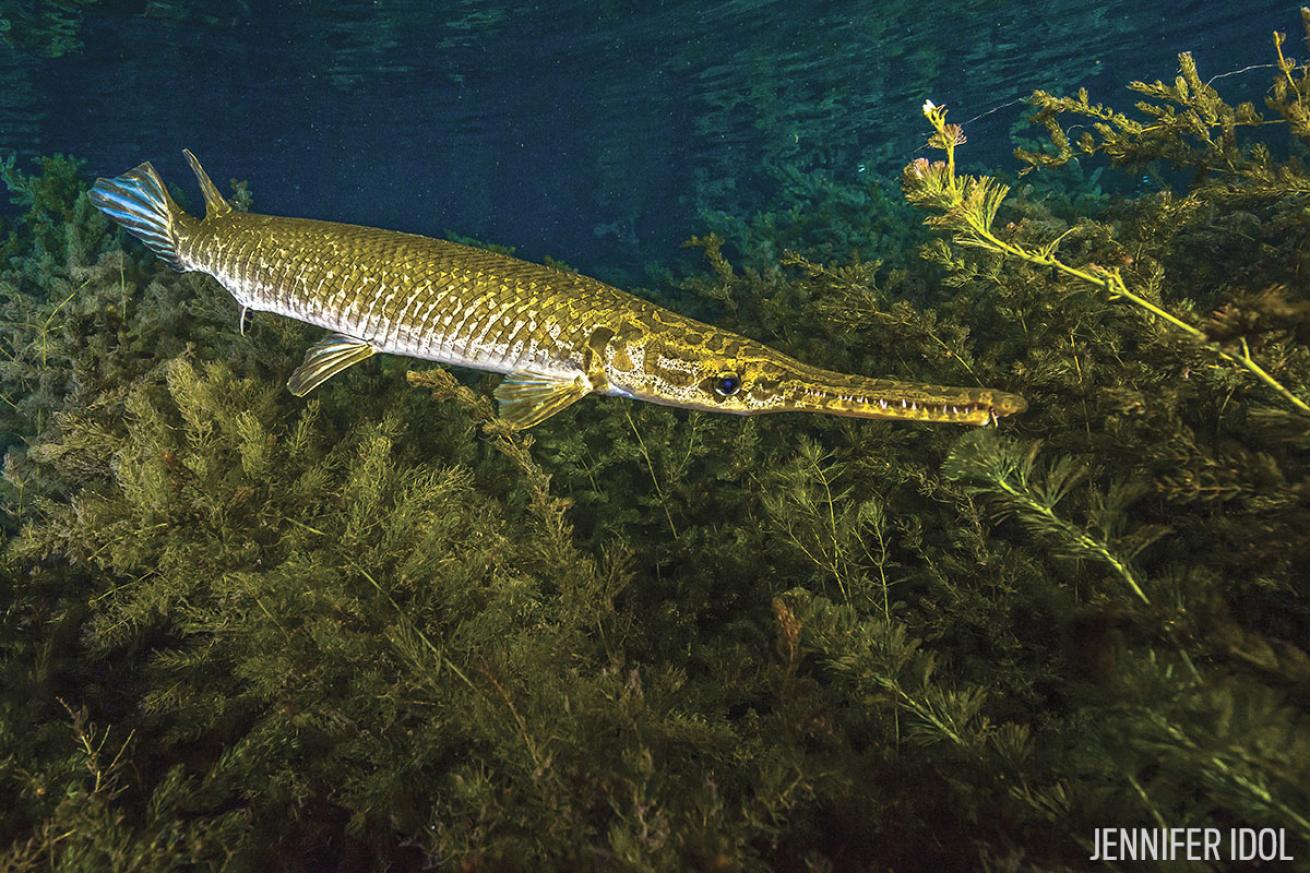
Jennifer IdolA spotted gar hunts in Spring Lake.
To dive here, each diver completes an educational Dive Authorization Course, held on Saturdays as often as twice a month. The course includes an orientation, a tour of the springs from a glassbottom boat, a buoyancy test and a tour from the training area to Deep Hole, the deepest spring in the lake.
If the course doesn’t fit into your schedule, the springs are still a fun visit. You can tour the spring on the glassbottom boat for a nominal fee and see the springs bubbling through limestone gravel.
RESPITE FROM THE CITY
Austin has grown from a sleepy college town into a bustling metropolis with traffic patterns similar to Los Angeles. The hill country begins just west of the city and surrounds the Highland Lakes system, a chain of six freshwater lakes.
The deepest of these reservoirs, Lake Travis, is considered the hub of our local diving, with a multitude of dive sites. The lake is part of the Colorado River system and is managed by the Lower Colorado River Authority (LCRA). Mansfield Dam is both the dam that forms the lake and a dive site.
I feel like I’m leaving the city behind when I drive to either a shore-diving site or to meet Giant Stride, a charter boat moored at the Aquaholics Watercraft Rental marina. As I wind around the lake, I am rewarded by glimpses of the lake below.
Robert Weiss operates Lake Travis Scuba and leads charters on Giant Stride throughout the year. Destinations include Starnes Island, Oasis Wall, Wreck Alley, West Point and Shaker Plant, the remnants of a rock-crushing and separation plant used for the construction of the dam. Starnes Island and Oasis Wall are my favorite of these sites because they are easy to navigate and feature interesting limestone terraces.
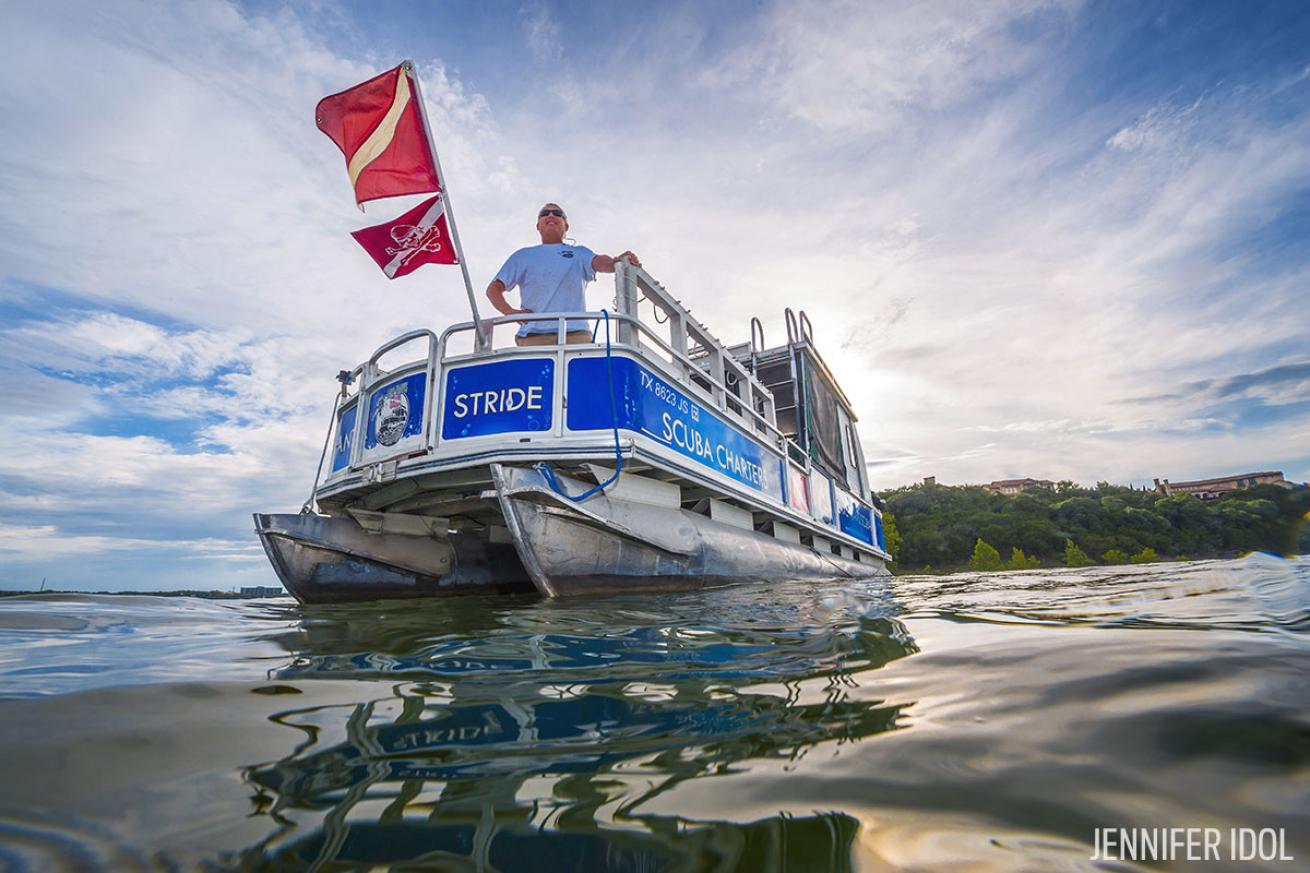
Jennifer IdolRobert Weiss leads charters from Giant Stride.
Thousands of sunglasses, items of jewelry, GoPros, cellphones and other personal items that party-barge guests accidentally drop in the lake during their activities are recovered on dives from Giant Stride. Starnes Island produces most of the treasure.
Weiss is animated when he talks about the lake. “I enjoy the beauty of our lake and the water out here. It’s a beautiful natural resource that we have in central Texas.”
Shore diving includes Windy Point Park, Bob Wentz Park at Windy Point, and Mansfield Dam. Four sets of stairs lead the way from Windy Point Park to eight platforms and dive artifacts that include turtle and shark sculptures, two large sailboats, and a small sailboat. I occasionally find the diver sculpture near the “tunnel of love” — a short pipe you can swim through.
I see catfish, drum and bass throughout the lake. On the rare occasion, I’ve seen clear freshwater shrimp in silty areas. We also hunt for Cretaceous fossils, created when this part of Texas was part of the ocean.
The history and diversity of central Texas diving directly contributed to my career as an underwater photographer. Returning reminds me of how fortunate we are to have accessible fresh water for recreational uses, and gives me a true feeling of freedom out on the water.
WHEN TO GO The best viz tends to be in winter or early spring; visit in April or May for optimal conditions with a thick wetsuit or drysuit. By June, waters are warm enough for 5 mm wetsuits.
DIVE CONDITIONS Water temps are an average 72 degrees F in late spring or early summer. Spring Lake and the Comal River feature year-round 72-degree temps. Viz can reach 100 feet in Spring Lake and 15 in Lake Travis, depending on depth. Lake temps can be in the 60s even during early summer. The Comal River and San Marcos River have average depths of 8 feet. Spring Lake averages a depth of 15 feet. Lake Travis reaches a depth of 210 feet.
OPERATORS Book online with Lake Travis Scuba and visit Windy Point Park. Dive World, Scubaland, Tom’s Dive and Swim, and Dive San Marcos can provide rental equipment.
PRICE TAG Plan to spend between $15 and $302 (with $230 Dive Authorization Course) on diving, depending on your budget and schedule.
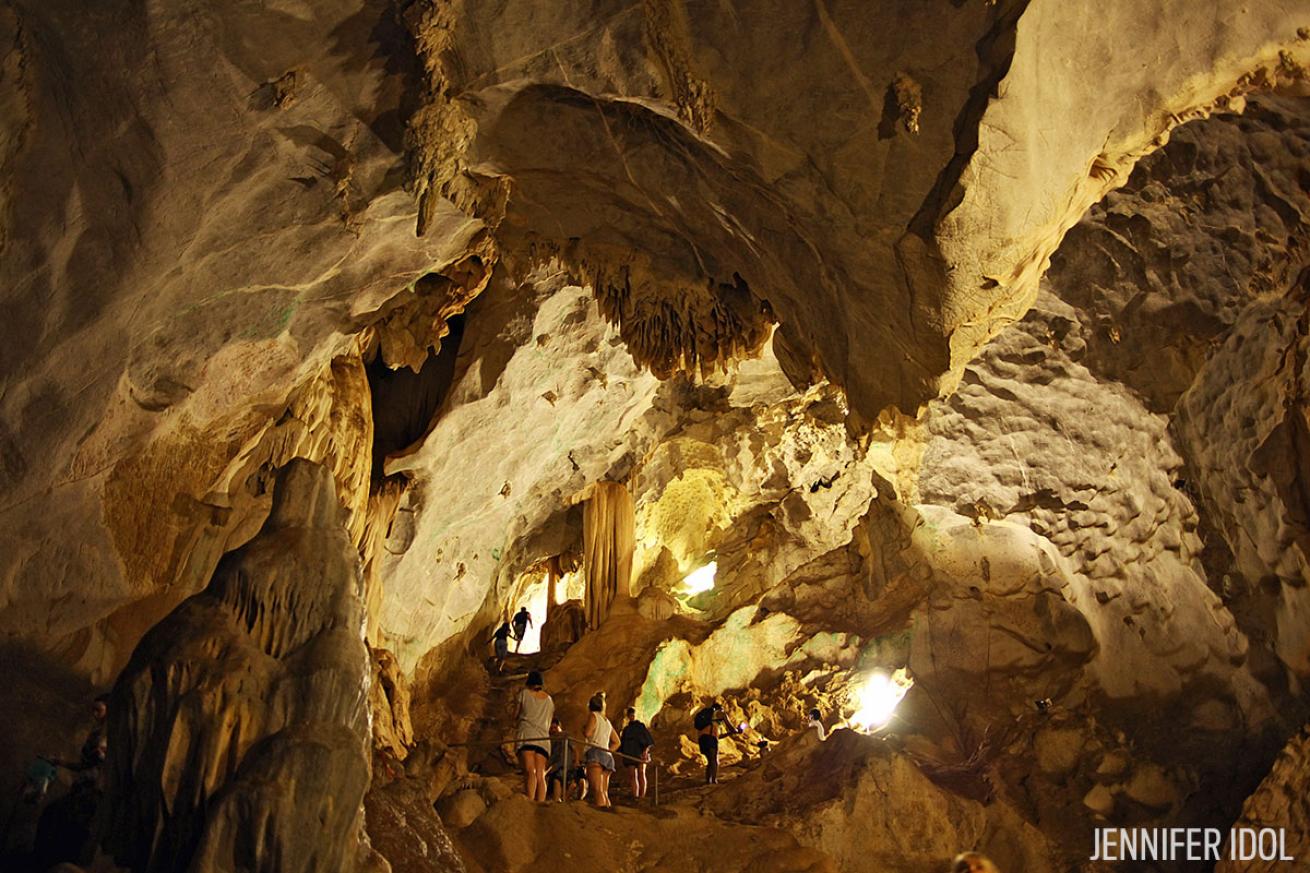
Jennifer IdolNatural Bridge Caverns.
3 Day Central Texas Itinerary
DAY ONE
Start with an early morning dive in the Comal River. Grab lunch and gas at Buc-ee’s. If you’re spending the next day at Spring Lake, you might want to dive the San Marcos River in the afternoon. Otherwise, visit Natural Bridge Caverns to see dry cave formations. Have dinner at Rudy’s Country Store and Bar-BQ in New Braunfels. For nightlife, see what’s playing at historic Gruene Hall for music and dancing.
DAY TWO
Spend the day at Spring Lake or dive in the San Marcos River, and have lunch at Root Cellar Cafe & Brewery. Then, see the springs from the glass-bottom boats on Spring Lake. Finish the day with dinner at Palmer’s Restaurant, Bar & Grill.
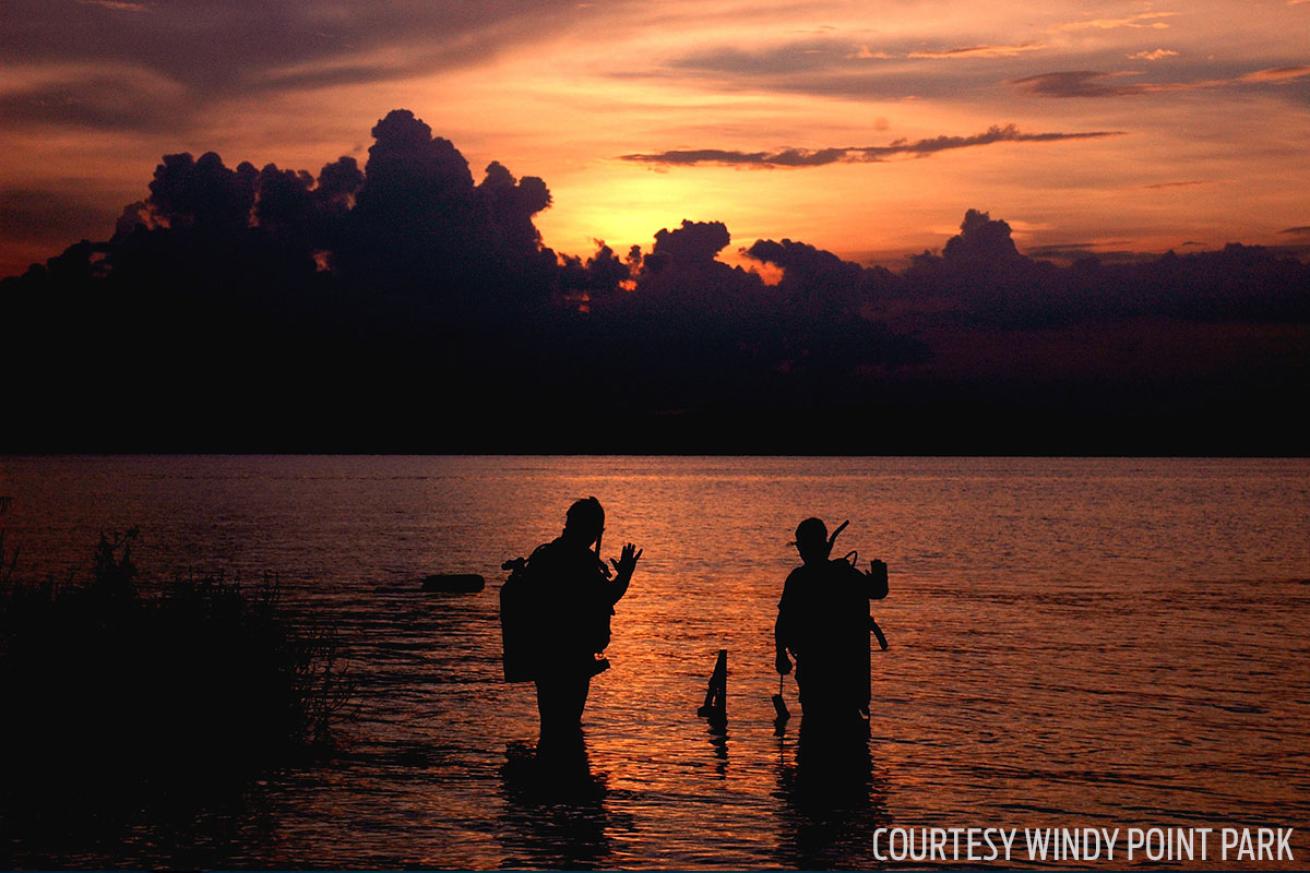
Courtesy Windy Point ParkEnjoy a morning dive with Lake Travis Scuba.
DAY THREE
Enjoy a morning diving with Lake Travis Scuba. If you dive in the morning, grab lunch at Freebirds World Burrito. Dive again from Windy Point Park. Enjoy drinks and sunset at The Oasis on Lake Travis, or have dinner with drinks at Black Walnut Café – Four Points.










